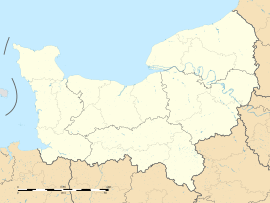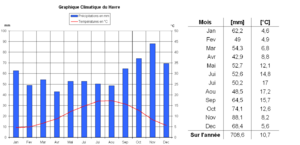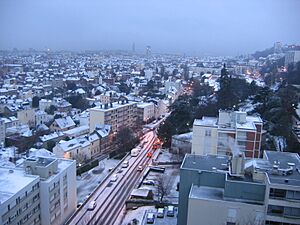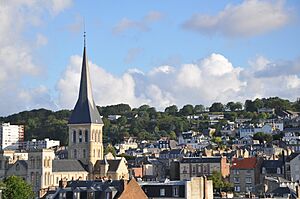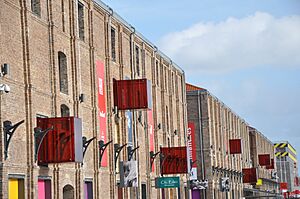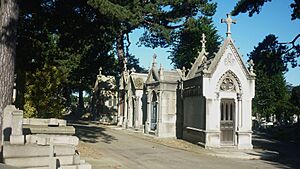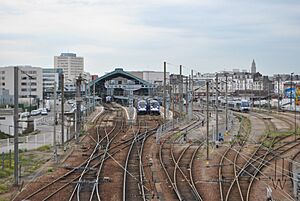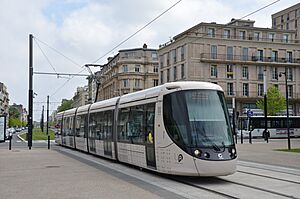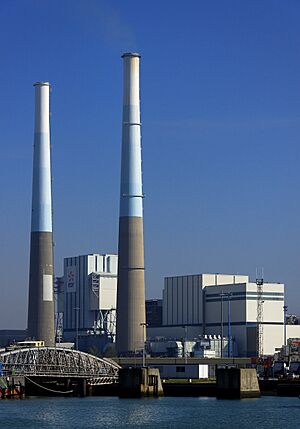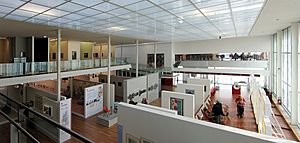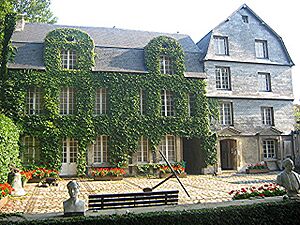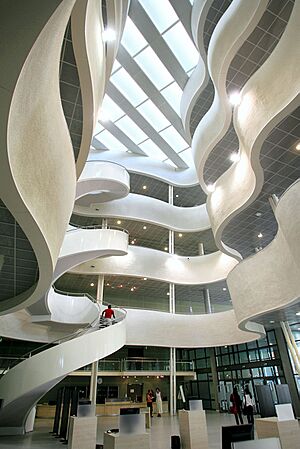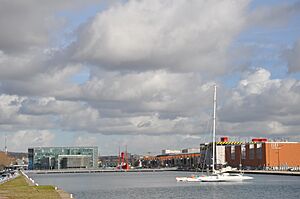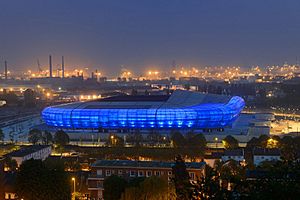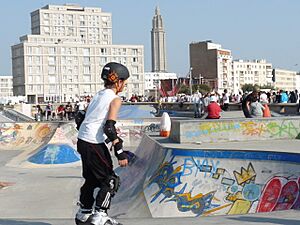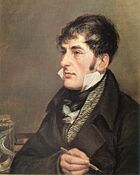Le Havre facts for kids
Quick facts for kids
Le Havre
Lé Hâvre (Norman)
|
|||
|---|---|---|---|
|
Subprefecture and commune
|
|||
|
|
|||
|
|||
| Country | France | ||
| Region | Normandy | ||
| Department | Seine-Maritime | ||
| Arrondissement | Le Havre | ||
| Canton | Le Havre-1, 2, 3, 4, 5 and 6 | ||
| Intercommunality | Le Havre Seine Métropole | ||
| Area
1
|
46.95 km2 (18.13 sq mi) | ||
| • Urban
(2018)
|
194.9 km2 (75.3 sq mi) | ||
| • Metro
(2018)
|
995.8 km2 (384.5 sq mi) | ||
| Population
(2021)
|
166,058 | ||
| • Rank | 15th in France | ||
| • Density | 3,536.9/km2 (9,160.6/sq mi) | ||
| • Urban
(2018)
|
234,945 | ||
| • Urban density | 1,205.46/km2 (3,122.1/sq mi) | ||
| • Metro
(2018)
|
337,086 | ||
| • Metro density | 338.508/km2 (876.73/sq mi) | ||
| Time zone | UTC+01:00 (CET) | ||
| • Summer (DST) | UTC+02:00 (CEST) | ||
| INSEE/Postal code |
76351 /76600, 76610, 76620
|
||
| Website | www.lehavre.fr | ||
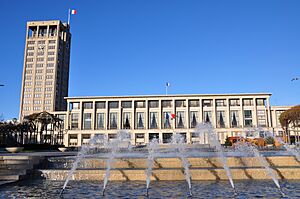 |
|||
| UNESCO World Heritage Site | |||
| Official name | Le Havre, the City Rebuilt by Auguste Perret | ||
| Criteria | Cultural: ii, iv | ||
| Inscription | 2005 (29th Session) | ||
| Area | 133 ha | ||
| Buffer zone | 114 ha | ||
| 1 French Land Register data, which excludes lakes, ponds, glaciers > 1 km2 (0.386 sq mi or 247 acres) and river estuaries. | |||
Le Havre is a big port city in northern France, located in the Seine-Maritime area of the Normandy region. It sits on the right bank of the estuary of the river Seine, right where it meets the Channel. Le Havre is also very close to the Prime Meridian. It is the most populated city in Upper Normandy. The name Le Havre means "the harbour" or "the port". People from Le Havre are called Havrais or Havraises.
King Francis I founded the city and port in 1517. In its early years, growth was slow due to wars, diseases, and storms. Le Havre really started to grow from the late 1700s. Its port became very important for international trade. After heavy bombings in 1944, the city was rebuilt using concrete, led by architect Auguste Perret. Industries like oil, chemicals, and cars grew a lot after the war. However, in the 1970s, the city faced economic challenges.
In the 1990s and 2000s, Le Havre changed a lot. The city worked to develop service jobs and new industries like aeronautics and wind turbines. A big port project called Port 2000 helped it compete with other European ports. This project also changed the southern parts of the city. Today, Le Havre is still known for its port and sea traditions. Its port is the second largest in France for total goods moved. It is also the biggest French port for containers.
In 2005, UNESCO named the central part of Le Havre a World Heritage Site. This was because of its unique way of being rebuilt after World War II. The André Malraux Modern Art Museum has the second largest collection of Impressionist paintings in France. The city has also won awards for its beautiful flowers and green spaces.
Contents
- Understanding the Name of Le Havre
- Exploring the History of Le Havre
- Geography and Environment of Le Havre
- City Layout and Neighborhoods
- Getting Around Le Havre
- Le Havre's Population and Economy
- Culture and Arts in Le Havre
- Education in Le Havre
- Sports and Recreation in Le Havre
- Media and Religion in Le Havre
- Famous People from Le Havre
- See also
Understanding the Name of Le Havre
The town's name was first recorded in 1489 as le Hable de Grace. Then it was called Ville de Grace in 1516, just before it was officially founded. For a short time, it was also known as Franciscopolis, honoring King Francis I. During the French Revolution, it was even called Havre Marat.
The name -de-Grace likely came from the Chapel of Notre Dame. This chapel was located where the cathedral is now. It faced another chapel, Notre Dame de Grace, across the estuary in Honfleur. The word havre used to mean "port" but is not common today. However, you might still hear "havre de paix", which means "safe haven".
Some experts think the word havre came from Middle Dutch in the 12th century. But newer research suggests it might be from the Norman language. Old Norman texts from the 12th century used similar words like Hable or havene. This makes a Scandinavian origin more likely. The old Scandinavian word höfn means "natural harbour" or "haven".
Exploring the History of Le Havre
The city was founded in 1517 by King Francis I. It was first called Franciscopolis after him. Later, it became Le Havre-de-Grâce, meaning "Harbor of Grace". The city was built to replace the older harbors of Honfleur and Harfleur. These older ports were becoming less useful because of too much silt.
The history of Le Havre is very connected to its harbor. In the 1700s, trade with the West Indies and other parts of Europe helped Le Havre grow. On November 19, 1793, during the French Revolution, the city's name changed to Hâvre de Marat. This was to honor Jean-Paul Marat. But by early 1795, the name was changed back to simply Le Havre.
During the 1800s, Le Havre became an important industrial city. At the end of World War I, it was a key port for managing post-war activities.
The city was heavily damaged during the Battle of Normandy in World War II. About 5,000 people died, and 12,000 homes were destroyed. After its capture in Operation Astonia, the city center was rebuilt. Architect Auguste Perret used a modernist style for the new buildings.
Symbols of Le Havre: Heraldry
 |
These are the current symbols of Le Havre. The salamander was the special sign of King Francis I. The lion comes from the Belgian coat of arms. It replaced a fleur-de-lis in 1926. This change honored the Belgian government that stayed in Le Havre during World War I. | The shield is red. It shows a silver salamander with a gold crown and flames. At the top, on a blue background, are three gold fleur-de-lis. In the bottom corner, there is a black section with a gold lion. |
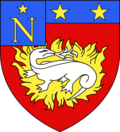 |
These were the symbols of Le Havre during the First French Empire. | The shield is red. It shows a silver salamander with a gold crown and flames. At the top, on a blue background, are three gold stars. In the bottom corner, there is a blue section with a gold letter "N" and a gold star above it. |
Geography and Environment of Le Havre
Where is Le Havre Located?
Le Havre is about 50 kilometers (31 miles) west of Rouen. It is on the coast of the English Channel and at the mouth of the Seine river. Major roads like the A29 autoroute from Amiens and the A13 autoroute from Paris connect to Le Havre.
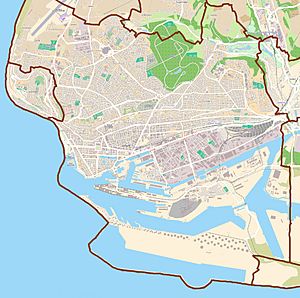
Le Havre is in the western part of the Seine-Maritime area in the Normandy region. The city's urban area includes 17 towns and about 250,000 people. It is at the southwestern tip of the Pays de Caux region. Le Havre is bordered by the English Channel to the west and the Seine estuary to the south.
 |
Channel; Sainte-Adresse | Octeville-sur-Mer | Montivilliers |  |
| Channel | Gonfreville-l'Orcher | |||
| Channel | Villerville (left bank) | Honfleur (left bank) |
Understanding Le Havre's Landscape
Le Havre is part of the Paris Basin, which formed millions of years ago. The land is made of sedimentary rocks. The city has two main parts, separated by a natural cliff. The lower part of the town, including the harbor and city center, was built on old marshland. This land was drained in the 1500s. The soil here is made of alluvium or silt from the Seine river. After World War II, the city center was rebuilt on a foundation of flattened rubble.
The upper town, to the north, is part of the cauchois plateau. The Dollemard area is its highest point, about 90 to 115 meters (295 to 377 feet) above sea level. This plateau has a layer of flinty clay and fertile silt. The main rock underneath is thick chalk, up to 200 meters (656 feet) deep. Because of the slope, the coast can have landslides.
Le Havre's Climate and Weather
Le Havre has a temperate oceanic climate because it is on the Channel coast. It is rarely calm, with winds often blowing. Temperatures usually stay above 0°C (32°F) and rarely go above 25°C (77°F). The city gets about 1,786 hours of sunshine each year.
Rainfall happens throughout the year, with more rain in autumn and winter. June and July sometimes have thunderstorms. The weather can change quickly, even during the day. Strong winds usually come from the southwest. Snowstorms can happen in winter, especially in January and February. The strongest wind ever recorded was 180 km/h (112 mph) on October 16, 1987.
The main natural risks are floods, storms, and storm surges. The lower town can have problems with rising water tables. There are no major rivers inside the city, so floods from overflowing rivers are not a concern. However, the beach can sometimes flood during strong storms. This happens when strong winds, big waves, and high tides combine.
Protecting Le Havre's Environment
A study found that Le Havre is one of the least polluted big cities in France. It also ranks third for air quality among cities with over 100,000 people. The city aims to reduce its carbon dioxide (CO2) emissions by 3% each year. To help with this, solar panels have been put on city buildings.
Since 2008, Le Havre has been part of the Energy Cities network. It follows plans like Agenda 21 to be more environmentally friendly. The city has won awards for its green efforts, like the "Energy of the Future" label. Since 1998, Le Havre's beach has received the Blue Flag award every year. This means it has good facilities and clean water.
Le Havre has many green spaces, totaling 750 hectares (1,853 acres). This means about 41 square meters (441 square feet) of green space per person. The biggest green areas are Montgeon Forest and Rouelles Park in the upper town. The Hanging Gardens and the gardens of the Priory of Graville offer great views. In the city center, Saint-Roch Square and the City Hall Gardens are popular spots. The Plateau of Dollemard is a "Sensitive Natural Area" protected for its landscape. The city's streets are lined with 13,000 trees of 150 different types.
City Layout and Neighborhoods
The Rebuilt City Center (Lower City)

Much of Le Havre was destroyed during World War II. It was rebuilt between 1945 and 1964 by architect Auguste Perret. Only the City Hall and the Church of Saint Joseph (107 meters or 351 feet tall) were designed by Perret himself. In 2005, UNESCO recognized Le Havre's reconstruction as a World Heritage Site. This area covers 133 hectares (329 acres). The buildings here use precast concrete and a modular design.
Another famous building in the city center is the House of Culture. It was built in 1982 by Brazilian architect Oscar Niemeyer. People call it "the Volcano" because of its unique shape. This building was updated in 2012, with changes approved by Niemeyer.
The Notre Dame and Perrey neighborhoods are mostly for homes. Les Halles is a main shopping area. The Saint Francis neighborhood was also rebuilt after 1950. But it has a different style, with brick buildings and sloped slate roofs. This area is known for its restaurants and fish market.
Older and Developing Neighborhoods
East and north of the rebuilt city center are older neighborhoods like Danton, Saint-Vincent, and Graville. These areas were not bombed in World War II. Their buildings are usually made of brick and date from the 1800s and early 1900s. Shops are found along main roads in the Rond-Point area. In the 1990s and 2000s, these neighborhoods were updated. This included fixing up old homes and adding new public buildings.
The area around the railway station has changed a lot recently. It is a main entry point to the city. New buildings have been built here, including the University of Le Havre and a new conservatory. Some of these were designed by famous architects. The bus station was also updated. North of the station, a new project is planned for 2013. It will include offices, a hotel, and shops.
Southern Districts: Industry and New Life
The southern parts of Le Havre are mostly for factories and port activities. You can find brick buildings from the 1800s, large housing areas, and industrial sites here. There are also warehouses, docks, and transport facilities.
These southern districts have been changing a lot with help from European funding. Areas that were once only industrial are now being used for new types of businesses. For example, the docks have been turned into sports and entertainment places (Dock Océane). There is also a shopping mall (Docks Vauban) and an exhibition hall (Docks Café). Les Bains Des Docks is a famous swimming complex designed by architect Jean Nouvel. New schools and clinics are also being built here. The City of the Sea and of Sustainable Development project is planned to attract many visitors.
Exploring the Upper Town
The upper town has three main parts: the "coast," the suburban areas on the plateau, and large housing estates.
The neighborhoods on the "coast" (the Dead Cliff) are mostly residential. The western part is wealthier, while the eastern part is more modest. The Jenner tunnel connects the upper town to the lower town. Two old forts, Forts Sainte-Adresse and Tourneville, are also on the coast. The main cemetery is the Sainte-Marie cemetery. These forts are now being used for new purposes. Fort Sainte-Adresse has the Hanging Gardens, and Fort Tourneville will host a music project called Tetris.
North of the "coast" are suburban areas like Rouelles, Sanvic, and Bleville. These grew in the first half of the 1800s. A new eco-friendly neighborhood called "Les Hauts de Bleville" is being built between Bleville and Octeville airport. It will have homes built to high environmental standards.
The large housing estates in Caucriauville, Bois de Bleville, and Mont-Gaillard grew after the war. These areas have many people who face economic challenges. In 2004, a big project started to fix up these neighborhoods. It includes demolishing and rebuilding over 1,700 homes.
Getting Around Le Havre
Travel Connections
Le Havre has worked to improve its transport links. The A131 highway connects Le Havre to the A13 autoroute over the Tancarville Bridge. This makes Rouen one hour away and Paris one and a half hours away. The A29 autoroute connects Le Havre to northern France. It crosses the Normandy Bridge, making Amiens two hours away and Caen one hour away.
The TER train network has been updated. The LER line opened in 2001, and direct services to Fécamp started in 2005. Thirteen Corail trains run daily between Le Havre station and Paris Saint-Lazare station. There is also a daily TGV high-speed train service to Marseille. Local trains also run from Le Havre station to Rolleville and Fécamp.
There is no direct train link between Le Havre and Caen. You need to go to Rouen by train or bus first. Buses also connect Le Havre to Étretat, Fécamp, and other towns in the Seine valley. AirPlus provides shuttle services to Paris airports and train stations.
Le Havre Octeville Airport is located 5 kilometers (3 miles) north of Le Havre. It is managed by CODAH. The main destination from this airport is Lyon. Many holiday flights are also offered.
Ferry services connect Le Havre to Portsmouth in England. Brittany Ferries now operates this route. The journey takes about five and a half to eight hours.
Public Transport in Le Havre

Le Havre has a good public transport network. This helps people travel between the lower and upper parts of the city. Long boulevards, winding roads, stairs, a funicular, and the Jenner tunnel connect the two areas.
The public transport network is called Lia. It is run by the Ocean Port Transport company (CTPO). The bus network was updated in 2008 to serve all towns in the area better. There are 19 regular bus routes and six evening routes called "Midnight Bus". About 100,000 passengers use the buses every day. A special shuttle service for the Industrial Zone and Port of Le Havre started in 2011. The funicular has connected the upper and lower towns in four minutes since 1890.
Le Havre used to have a tramway system from 1894 to 1957. A new tramway system opened on December 12, 2012. It has 23 stations and covers 13 kilometers (8 miles). The main line connects the beach to the station and then goes up to the upper town through a new tunnel. It then splits into two lines, going to Mont-Gaillard and Caucriauville.
Since 2001, the LER, a TER train line, connects Le Havre station to Rolleville. It passes through five other train stations in the urban area.
The city has also been building more bike paths since 2005. The total length of bike paths doubled between 2007 and 2011, reaching 46 kilometers (29 miles). You can rent bikes from bus agencies or the city hall. There are also 140 taxis in Le Havre.
Le Havre's Population and Economy
Population Changes in Le Havre
Le Havre's population grew quickly in the late 1800s. After World War I, the city gained many people by adding the town of Graville. But during World War II, the population dropped a lot due to people leaving and the bombings. After the war, the population grew again until 1975. Since then, it has decreased, especially between 1975 and 1982, during an industrial crisis.
The city's current goal is to build new homes and attract more residents. In 2018, about 169,733 people lived in Le Havre. The wider urban area had 234,945 people, and the metropolitan area had 337,086.
Between 2012 and 2017, more people were born than died in Le Havre. However, more people moved out of the city than moved in. In 2017, 19% of Le Havre's population was under 15 years old, and 39% were under 30. This is higher than the average for France. About 24% of men and 26% of women were over 60.
The most populated areas are the city center, Sanvic, Caucriauville, and Anatole France/Danton. In 2009, about 4.8% of the population were foreigners. Most immigrants came from North Africa or other parts of Africa.
The types of jobs in Le Havre have changed a lot since the 1980s. The number of factory workers has decreased. At the same time, the number of managers and professionals has increased. This is partly because of the growth of the University of Le Havre. In 2017, Le Havre had fewer managers and more workers than the national average. The unemployment rate also increased between 2007 and 2017. More people in Le Havre have short-term jobs compared to the national average. However, the number of people with higher education degrees has increased a lot.
Le Havre's Economy: A Closer Look
Le Havre's economy is strong and varied. It relies heavily on large industrial sites and international companies. However, many decisions are made outside the city, mainly in Paris. Some local companies, like Sidel Group and Delmas, have become very successful.
| Name | Location | Industry |
|---|---|---|
| Renault Sandouville | Sandouville | Cars |
| Centre Hospitalier Général | Le Havre | Healthcare |
| Le Havre Commune | Le Havre | Public Administration |
| TotalEnergies | Gonfreville | Oil Refining |
| Port Authority of Le Havre | Le Havre | Port Services |
| Aircelle | Gonfreville | Aircraft Parts |
| Total Petrochemicals | Gonfreville | Petrochemicals |
| SNCF | Le Havre | Transport |
| Dresser-Rand | Le Havre | Mechanical Equipment |
| Chevron | Gonfreville | Petrochemicals |
The Important Port of Le Havre
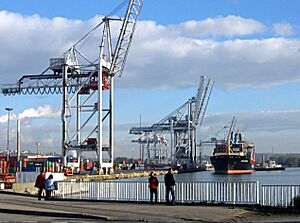
The port of Le Havre is the second largest French seaport. In 2011, it handled 68.6 million tons of goods. It handles 60% of all container traffic in France. This makes it the eighth largest port in Europe for containers. The port also receives many oil tankers, bringing in crude oil and refined products. In 2010, over 340,500 vehicles passed through its Roll-on/roll-off terminal. About 75 shipping lines connect Le Havre to 500 ports worldwide. Asia is the port's biggest trading partner.
Le Havre's location is great because it is on one of the busiest waterways in the world. It is also the first and last port in the "North Range" of European ports. This is the largest port area in Europe. As a deepwater port, it can handle all types of ships at any time. Since it was founded in 1517, the port has grown a lot. Today, it is 27 kilometers (17 miles) long from east to west and about 5 kilometers (3 miles) wide. The latest big project, Port 2000, increased its capacity for handling containers.
The port provides 16,000 direct jobs in the Le Havre area. Many more jobs are created indirectly in industries and transport. In 2006, distribution and warehousing jobs were the most common, followed by road transport and handling.
In 2011, over 715,000 passengers passed through the port. There were also 95 visits from cruise ships, carrying 185,000 passengers. The port expects even more cruise ship visits in the future. The leisure boat harbor, built in 1934, is the largest in the English Channel. It can hold 1,160 boats. There is also a small fishing port in the Saint-François district.
Industry in Le Havre
Most of Le Havre's industries are in the industrial-port area. The largest industrial employer is the Renault car factory in Sandouville, with 2,400 employees. The petrochemicals sector is also very important. The Le Havre area has over a third of France's oil refining capacity. It produces about 50% of basic plastics and 80% of additives and oils. Many researchers work in private and public laboratories here. Large chemical companies are located in Le Havre, Montivilliers, and Sandouville.
Several companies in the aerospace industry are also here. SAFRAN Nacelles, which makes parts for Airbus and Boeing, is in Harfleur. It employs 1,200 people from the Le Havre area. Dresser-Rand SA makes equipment for the oil and gas industry. In the energy sector, the EDF thermal power plant in Le Havre uses coal to produce electricity. The AREVA group plans to open a factory in the port to build wind turbines. This project is expected to create about 1,800 jobs.
Other industries are spread throughout Le Havre. The Brûlerie du Havre roasts coffee. Sidel designs and makes machines for plastic bottles.
Services Sector in Le Havre
The two biggest employers in the service sector are the Groupe Hospitalier du Havre (hospital group) and the City of Le Havre itself. The city has many service companies related to port operations, like shipping and marine insurance companies. The headquarters of Delmas (transport) and SPB (insurance) are located here.
Transport is the largest economic sector in Le Havre, providing 15.5% of jobs. Logistics jobs are also very common. The ISEL trains engineers in this field. The University of Le Havre and other higher education institutions also contribute to the service sector.
Tourism is growing in Le Havre. The city has a blue flag rating and is a World Heritage Site. It is also a "French Towns and Lands of Art and History" city. The growth of cruise ship visits and projects like the City of the Sea are helping tourism. In January 2020, the city had 26 hotels with 1,428 rooms.
The Chamber of Commerce and Industry of Le Havre manages the Le Havre Octeville Airport.
Culture and Arts in Le Havre
Events and Festivals in Le Havre
Le Havre has many exciting events and festivals throughout the year.
In spring, there is a Children's Book Festival. In May, the Fest Yves celebrates Breton culture in the Saint-François district. In June, a jazz festival called Dixie Days takes place on the beach. In July, the Polar room at the Beach features detective novels. The Z'Estivales event offers many street art shows all summer. In August, the MoZaïques festival brings world music to Fort Sainte-Adresse. In mid-August, a beautiful Flower parade goes through the city streets.
In early September, the Festival of the Sea celebrates the ocean. This includes a race between Le Havre and Bahia in Brazil. Every November, a fair is held at the Docks Café. The Autumn Festival in Normandy offers concerts, theater, and dance from September to November. In late October, a rock music festival takes place at Fort Tourneville.
Since 2006, a Biennale of contemporary Art has been organized by the Partouche group.
Le Havre's Buildings and Heritage
Many buildings in Le Havre are classified as "historical monuments." In the 2000s, Le Havre's architecture gained more recognition. The city was named "City of Art and History" in 2001. Then, in 2005, UNESCO made the city of Le Havre a World Heritage Site.
The oldest building still standing is the Graville Abbey. Another old building is the Chapel of Saint-Michel of Ingouville. Because of the 1944 bombings, there are few buildings left from earlier times. The Le Havre Cathedral, the Church of Saint Francis, and the Museum of the Hotel Dubocage of Bleville are some examples. The 1800s buildings show the city's sea and military past. These include the Hanging Gardens and the Vauban docks.
The buildings from the 1950s and 1960s, designed by the Auguste Perret workshop, are very special. The Church of Saint Joseph and the Town Hall are key examples. The curved design of the "Volcano", by Oscar Niemeyer, stands out from the straight lines of the rebuilt center. Many new buildings from the 21st century also show modern architecture.
Churches in Le Havre
- Le Havre Cathedral: The first stone was laid in 1536. It is the main church of the Bishop of Le Havre.
- Church of Saint Joseph: One of the city's most famous symbols. Its bell tower is 107 meters (351 feet) high. Auguste Perret designed it.
- Church of Saint Michel
- Church of Saint Vincent
- Church of Saint François
- Church of St. Anne
- Church of Saint Marie
- Chapel of Saint Michel d'Ingouville (15th century)
- Graville Abbey: A monastery dedicated to Sainte Honorine, located on the northern bank of the Seine River.
- Presbyterian Reform Church (Église Réformée): Built in 1857, bombed in 1941. Its roof and ceiling were rebuilt in 1953 by architects from Auguste Perret's office. It is the only building in town that mixes old and new Perret styles.
Museums to Explore
Five museums in Le Havre are officially recognized as Musées de France (Museums of France).
André Malraux Modern Art Museum – MuMa
The most important of the five, Museum Malraux was built in 1955. It opened in 1961. This museum has art from the late Middle Ages to the 20th century. Its collection of Impressionist paintings is the second largest in France, after the Orsay Museum in Paris. You can see paintings by Claude Monet, Auguste Renoir, Raoul Dufy, and Edgar Degas.
Museum of Old Le Havre (Musée du Vieux Havre)
This museum tells the story of Le Havre. It has many items from the old days and the 1800s, like furniture, old maps, statues, and paintings.
Natural History Museum (Musée d'histoire naturelle)
The Museum of Natural History was founded in 1881. It was badly damaged in World War II. It is in Le Havre's former law courts, built in the mid-1700s. The museum has collections of minerals, animals, birds, fossils, and prehistoric items. It also has 8,000 paintings from the 1800s by Charles-Alexandre Lesueur. The museum was destroyed in 1944, and many collections were lost.
The Shipowner's House
This house from the 1700s is also dedicated to Le Havre's history. Like the Museum of Old Havre, it has many old items, furniture, maps, and paintings.
Museum of the Priory of Graville
The Museum at the Priory of Graville shows many religious art pieces. These include statues and other religious objects. It also has the Gosselin collection of 206 model houses.
Other Interesting Museums
Other smaller museums show Le Havre's history and its connection to the sea. The apartment-control (Apartement-Temoine) is a standard apartment from the 1950s. It shows what daily life was like back then. The maritime museum has objects related to the sea and the port. There are also many art exhibitions in the city, like the SPOT for contemporary art. The municipal library also hosts exhibitions.
Other places to visit include:
- The former tribunal (18th century)
- The Town Hall: its modern belfry now holds offices.
- The "Volcan" cultural center by Oscar Niemeyer.
- Square St. Roch.
- Japanese Garden.
Theaters, Auditoriums, and Concerts
Le Havre has two main cultural areas: the city center and the Eure district. The Espace Oscar Niemeyer includes the "Great Volcano," a national theater with 1,093 seats. It also has the "Little Volcano," a smaller hall for performances. The "Little Volcano" is being turned into a multimedia library. Performances from the "Great Volcano" are currently held in the old ferry terminal. Other cultural places in the city center are also being updated. Le Tetris at Fort Tourneville will be a place for contemporary music, opening in 2013.
Other cultural venues in the city center include the cinema Le Studio, the City Hall theater (700 seats), and the Little Theatre (450 seats). The National Choreographic Centre of Le Havre specializes in dance shows.
The second cultural center is in the Eure district, near the Basin Vauban. Docks Océane is a large hall for concerts, shows, and sports events. It can hold up to 4,700 people. The biggest cinema in Le Havre is at the Docks Vauban. The Docks Café is an exhibition center. The Magic Mirrors offers many concerts.
A new auditorium, Le Tetris, is being built at Fort Tourneville. It will open in September 2013 with a festival. It will have two halls for 800 and 200 people, exhibition space, and a restaurant. Le Tetris will host contemporary music, theater, dance, and visual arts.
Libraries and Archives
The main library, named after writer Armand Salacrou, is in the city center. It has branches in all districts. A new multimedia library at the "Volcano" is being updated for 2014. Many books are available in specialized libraries at the Higher School of Art, the Museum of André Malraux, and the Natural History Museum. Old manuscripts are kept at the public library. The city's archives, at Fort Tourneville, have documents from the 1500s to the 1900s.
Le Havre in Art and Film

The Port of Le Havre and the light on the Seine estuary have inspired many painters. Artists like Louis-Philippe Crepin, Jean-Baptiste Corot, and Eugène Isabey painted here. Eugène Boudin created many paintings of Le Havre in the 1800s. Artists from other countries, like William Turner and Johan Barthold Jongkind, also painted the city.

Claude Monet (1840–1926), who lived in Le Havre, painted Impression soleil levant (Impression, Sunrise) in 1872. This painting gave its name to the impressionist art movement. He painted many sea scenes in the Le Havre area. The Musée Malraux has some of his paintings. Other Impressionists like Camille Pissarro and Maxime Maufra also painted the port.
The Fauvism art movement also had many artists who trained in Le Havre. These included Othon Friesz, Raoul Dufy, and Georges Braque. They painted many scenes of the city and port.
Le Havre has been featured in nearly 70 films. Directors have chosen the port for their movies, such as L'Atalante (1934) and Le Quai des brumes (1938). The city has also been a setting for comedies like Le Cerveau (1968) and Disco (2008). The film Le Havre by Aki Kaurismäki won awards at the 2011 Cannes Film Festival.
Le Havre in Books and Stories
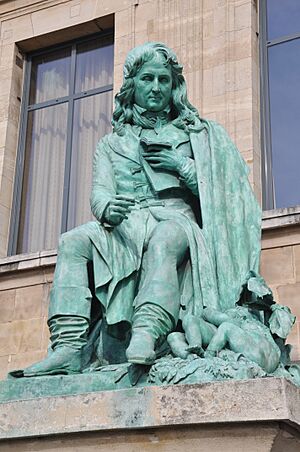
Le Havre appears in many books as a starting point for journeys to America. In the 1700s, Father Prevost's characters in Manon Lescaut left from Le Havre.
In the 1800s, Le Havre was the setting for several French novels. Honoré de Balzac described a merchant family's struggles in Modeste Mignon. The Norman writer Guy de Maupassant set parts of his works, like Pierre et Jean, in Le Havre. Alphonse Allais also set his stories here. La Bête humaine by Émile Zola talks about the railway world in Le Havre. Streets and buildings in Le Havre are named after famous people from this time, like writer Casimir Delavigne.
In the 1900s, Henry Miller set part of his book Tropic of Cancer in Le Havre. Jean-Paul Sartre was inspired by Le Havre for his novel La Nausée (The Nausea). Raymond Queneau, born in Le Havre, used the city as a setting for his novel Un rude hiver. The plot of Une maison soufflée aux vents by Émile Danoën took place in Le Havre during World War II.
Diana Gabaldon set part of her novel Dragonfly in Amber (1992) in Le Havre. Two mystery novels by Georges Simenon and Gaston Leroux also take place here. In Rouge Brésil, Jean-Christophe Rufin describes Le Havre in the 1500s as the port where French explorers left for the New World.
Benoît Duteurtre's book Le Voyage en France (2001) describes Le Havre in its first part. In 2008, he wrote Les pieds dans l'eau, an autobiographical book about his youth in Le Havre.
Le Havre also appears in comic books. In L'Oreille cassée (1937), Tintin leaves from Le Havre for South America. The first adventure of Ric Hochet (1963), Traquenard au Havre, shows the seaside and port.
Music from Le Havre
Le Havre is the birthplace of many musicians and composers. These include Henri Woollett, André Caplet, and Arthur Honegger. Victor Mustel was famous for improving the harmonium.
Le Havre has long been known as a center for French rock and blues music. In the 1980s, many groups emerged. Little Bob is a famous rock musician from Le Havre who started in the 1970s. A blues festival called Blues a Gogo was held from 1995 to 2002.
Today, the musical tradition continues with the Symphony Orchestra of Le Havre and the Conservatory Arthur Honegger. Associations like Papa's Production support local artists. The West Park Festival has been held at Fort Tourneville since 2004. The I Love LH association promotes Le Havre's culture and music scene.
Board Game: Le Havre
Le Havre is a board game about the growth of the town of Le Havre. It was inspired by other games and was created in December 2007.
Norman Language Influence
The Norman language has left its mark on the way people speak in Le Havre. Some people speak the Cauchois dialect. Common Norman words used in Le Havre include: boujou (hello, goodbye), clenche (door handle), morveux (veuse) (child), and bezot (te) (last born).
Education in Le Havre
Schools for All Ages
Le Havre is part of the Academy of Rouen. The city runs 55 kindergartens and 49 primary schools. The department manages 16 middle schools (collèges), and the Normandy region manages 9 high schools. Some schools are in "priority education zones" to help students who need extra support. A special "boarding school of excellence," the Claude Bernard college, opened in 2011. The first middle school in Le Havre dates back to the 1500s. The François I high school is the oldest in Le Havre. Famous thinkers like Jean-Paul Sartre and Raymond Aron taught there. Writer Armand Salacrou also studied there.
Public Middle Schools (collèges)
- Collège Claude Bernard
- Collège des Acacias
- Collège Descartes
- Collège Eugène Varlin
- Collège Gérard Philipe
- Collège Guy Moquet
- Collège Henri Wallon
- Collège Irène Joliot-Curie
- Collège Jacques Monod
- Collège Jean Moulin
- Collège Jules Vallès
- Collège Léo Lagrange
- Collège Raoul Dufy
- Collège Romain Rolland
- Collège Théophile Gautier
- Collège Marcel Pagnol
Private Middle Schools
- Collège du Sacré Cœur
- Collège Saint-Joseph
- Collège Les Ormeaux
- Collège Montesquieu
Public High Schools (lycées)
- Lycée Claude Monet
- Lycée général et technologique Porte-Océane
- Lycée François I
- Lycée général et technologique Robert Schuman
- Lycée Jules Siegfried
Private High Schools
- Lycée Saint-Joseph
Public Vocational High Schools
- Lycée technique et professionnel Françoise de Grâce
- Lycée professionnel Jules Lecesne (Hotel trades and services)
- Lycée professionnel Jules Siegfried (Electronic and Mechanical trades)
- Lycée professionnel Antoine Laurent de Lavoisier (Transport and Logistics – Metallic structures – automobiles)
- Lycée professionnel Auguste Perret (Housing trades)
- Lycée professionnel Claude Monet (Accounting – Secretarial)
- Lycée professionnel Porte Océane (Accounting – Secretarial)
- Lycée professionnel Robert Schuman (Industry)
Private Vocational High Schools
- Lycée professionnel Germaine Coty
- Lycée professionnel Saint Vincent de Paul
- Lycée professionnel Jeanne d'Arc
Higher Education and Special Schools
In 2011, about 12,000 students were studying in Le Havre. The University of Le Havre, opened in 1986, is well-located near the train and tram stations. It has a library, gym, dining halls, and student housing. In 2010–2011, over 6,900 students were enrolled. The university also trains engineers, including those at the Logistical Studies Higher Education Institute (ISEL). Many courses are related to port operations, logistics, and industry. Twelve languages are taught, and 17% of students are from other countries. The University of Le Havre is also a research center.
The University Institutes of Technology of Le Havre has two main sites. One is in the upper town, and the other is in the Eure district. It has 1,881 students in ten departments. There is also a branch of the teacher training institute of Rouen (IUFM).
Le Havre has many specialized higher education institutions. The École Supérieure de Commerce du Havre, founded in 1871, is one of the oldest business schools in France. It merged to create the Normandy Business School in 2006. This school had over 2,800 students on five campuses in 2015. Since 2007, the Institute of Political Studies of Paris has had a Euro-Asia program in Le Havre. The National School of The Merchant Marine trains officers for merchant ships. It will move to the Bassin Vauban in 2015. The National Higher School of Petrol and Motors (ENSPM) trains petroleum engineers. The ITIP trains students for careers in transport and port business. The National Institute of Applied Sciences of Rouen (INSA) opened a branch in Le Havre in 2008.
In the arts, the Conservatory Arthur Honegger has 1,680 students for music, dance, and drama. The Graduate School of Art of Le Havre (ESAH) offers art degrees. About 800 people study in paramedical and social schools, mostly at the IFSI (Institute of Training in Nursing).
Sports and Recreation in Le Havre
Le Havre has some of the oldest sports clubs in France. These include the Le Havre Rowing Society (1838) and the Regatta Society of Le Havre (1838). The Le Havre Athletic Club (1872) is the oldest French football and rugby club.
Le Havre also hosted the sailing events for the 1900 Summer Olympics and 1924 Summer Olympics.
The city has three main professional sports teams. The Le Havre AC football team was promoted back to Ligue 1 in 2023. Its training center is famous for training many French international players. The second team is Saint Thomas Basketball, which plays in the top French league. Thirdly, the HAC women's handball team plays in the first division. They won their first national title in 2006.
The city's connection to the sea is seen in many sports. Sailing has a long history here. In 1840, the first French pleasure boat regatta was held. Today, Le Havre is known for water sports and as a Seaside resort. The marina can host large boats at any time. It is the largest in Seine-Maritime with about 1,300 places to moor boats. The Havraise Rowing Society has trained many top rowers. The Club Nautique Le Havrais (CNH) is a center for swimming and water polo. The Centre Nautique Paul Vatine is one of the top clubs in the country for sports licenses.
Several famous local athletes started their careers in Le Havre. Swimmer Hugues Duboscq won several Olympic medals. In judo, Dimitri Dragin and Baptiste Leroy are from Le Havre. Jerome Le Banner is a professional kick-boxer. Sailor Paul Vatine, who was lost at sea in 1999, won the Transat Jacques Vabre race many times.
Sports Facilities in Le Havre
The city has 99 sports facilities. These include 46 gymnasiums, 23 sports fields, and 5 swimming pools. The Stade Océane (Ocean Stadium), opened in July 2012, replaced the old stadium. It has 25,000 seats and can host football matches and other events. Basketball and handball games are played in the Dock Océane hall. Ice hockey is played at the ice rink. Two of the city's swimming pools are run by the city. Les Bains Des Docks was designed by architect Jean Nouvel. Le Havre has the largest free outdoor skatepark in France, covering about 7,000 square meters (75,347 square feet).
The port allows for many water activities like sailing, fishing, canoeing, and rowing. The beach is a popular spot for kitesurfing, windsurfing, and surfing.
Sporting Events in Le Havre
Le Havre has hosted many major sports events. The Tour de France cycling race has passed through the city many times. Sailing events are often held here. The Transat Jacques Vabre transatlantic race has started from Le Havre every two years since 1993. The Solitaire du Figaro sailing race also included Le Havre in 2010.
Since 2006, freestyle board sports weekends have been popular. These include skateboarding, rollerblading, and kitesurfing. Every summer, rollerblade events are organized in the city on Friday evenings. The first International Triathlon was held in 2012. Runners can also take part in races like the "10 kilometers in Le Havre."
Media and Religion in Le Havre
Local Media Outlets
Five newspapers cover the Le Havre area. These include the daily papers Le Havre libre, Le Havre Presse, and Paris Normandie. Liberté-Dimanche is a Sunday edition of these papers. A free weekly newspaper, Le Havre Infos, is published every Wednesday.
Several magazines provide local information. LH Océanes is the municipal magazine, and Terres d'Agglo is the agglomeration area magazine. There are also free magazines like Aux Arts and Bazart for cultural information. HAC Magazine covers news about the HAC. Some newspapers are also available online.
A local TV news edition, France 3 Baie de Seine, is broadcast every evening. Radio Albatros is a local radio station on FM frequency 88.2. Other radio stations include Radio Vallée de la Lézarde and RCF Le Havre. Journalist and TV host Laurent Ruquier, born in Le Havre, started his career at local radio stations here.
Religious Life in Le Havre
In 1974, Pope Paul VI decided to create the diocese of Le Havre. This new diocese was formed from parts of the Archdiocese of Rouen. The church of Notre Dame became the Cathedral Notre Dame du Havre. Today, Le Havre is divided into eight parishes with 24 places of worship. The oldest chapel is Saint-Michel d'Ingouville, from the 11th century. The Church of Saint Joseph du Havre, built by Auguste Perret, is very tall with its 107-meter (351-foot) spire. There are also several monasteries.
The Protestant Church of Le Havre was built in 1862. It was bombed in 1941 and rebuilt in 1953. It is the only building in Le Havre that combines 19th-century architecture with the modern Perret style. Le Havre also has seven evangelical Protestant churches.
The city has seven Muslim places of worship, including the En-Nour Mosque and El Fath Mosque. The synagogue, located in the rebuilt city center, was visited by President Jacques Chirac in 2002.
Famous People from Le Havre
Le Havre is the birthplace of many notable people:
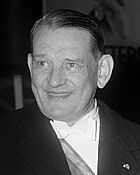
- Georges de Scudéry (1601–1667), a writer and poet.
- Madeleine de Scudéry (1607–1701), a writer.
- Jacques-Henri Bernardin de Saint-Pierre (1737–1814), a writer and botanist.
- Charles Alexandre Lesueur (1778–1846), a naturalist, artist, and explorer.
- Casimir Delavigne (1793–1843), a poet and dramatist.
- Frédérick Lemaître (1800–1876), an actor and playwright.
- Raoul Dufy (1877–1953), a painter.
- André Caplet (1878–1925), a composer and conductor.
- René Coty (1882–1962), who was the French president from 1954 to 1959.
- Arthur Honegger (1892–1955), a composer.
- Jean Dubuffet (1901–1985), an artist.
- Raymond Queneau (1903–1976), a poet and novelist.
- Laurent Ruquier (born 1963), a journalist.
Sports Stars from Le Havre
- Jérôme Le Banner (born 1972), a kickboxer.
- Vikash Dhorasoo, (born 1973), an international footballer.
- Dimitri Dragin (born 1984), a judoka.
- Julien Faubert (born 1983), a footballer.
Other Famous People Connected to Le Havre
- Jean-Paul Sartre (1905–1980), a famous philosopher, taught at the Lycée François-Ier.
- Christine Lagarde (born 1956), who became the head of the IMF, grew up in Le Havre.
See also
 In Spanish: El Havre para niños
In Spanish: El Havre para niños











